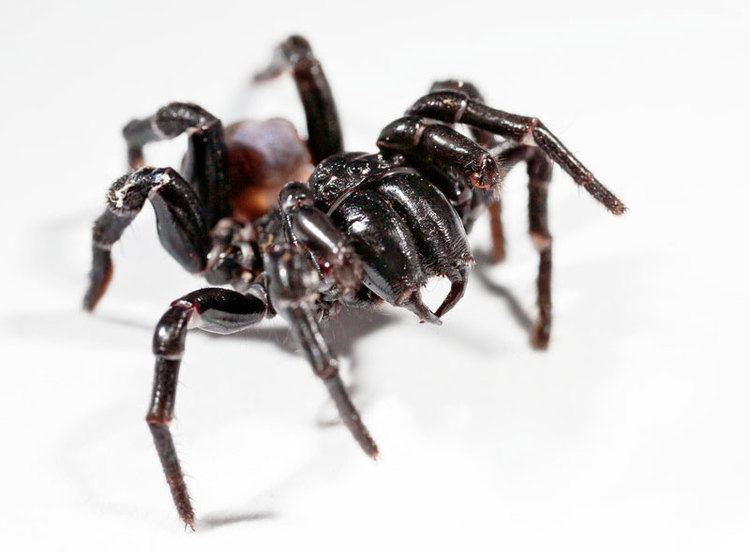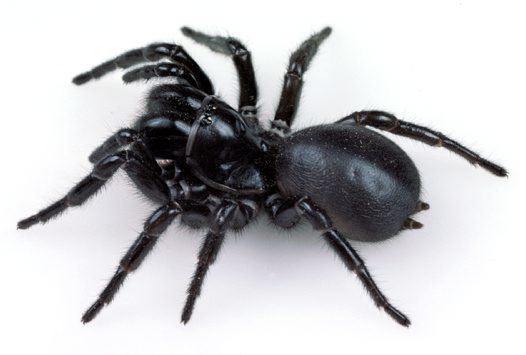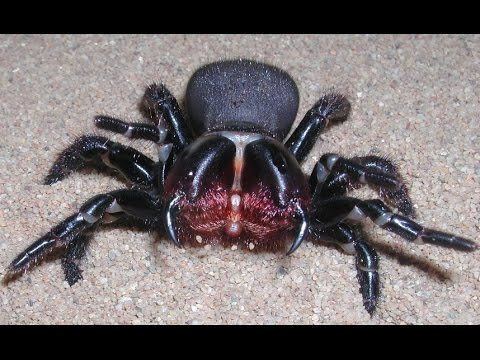Rank Species | Family Hexathelidae Higher classification Atrax Order Spider | |
 | ||
Similar Australian funnel‑web spider, Atrax, Redback spider, Brazilian wandering spider, Wandering spider | ||
The Sydney funnel-web spider (Atrax robustus) is a species of venomous mygalomorph spider native to eastern Australia, usually found within a 100 km (62 mi) radius of Sydney. It is a member of a group of spiders known as Australian funnel-web spiders. Its bite is capable of causing serious injury or death in humans if left untreated.
Contents

Taxonomy

The Reverend Octavius Pickard-Cambridge was the first to describe the Sydney funnel-web spider, from a female specimen housed in the British Museum in 1877. Establishing the genus Atrax, he named it Atrax robustus. The species name is derived from the Latin robustus "strong/sturdy/mature". Some years later, William Joseph Rainbow described a male Sydney funnel-web as a new species—Euctimena tibialis—from a spider he found under a log in Turramurra, and another from Mosman. He coined the scientific name from the Ancient Greek euktimenos "well built" and Latin tibialis "of the tibia", having noted its prominent tibial spur. In the same paper, he described a female Sydney funnel web as yet another species—Poikilomorpha montana—from a specimen collected from Jamison Valley and Wentworth Falls in the Blue Mountains. Its species name was derived from poikilomorphia "variety of form" referring to the eyes of different sizes, and montana "of the mountains". In February 1927, a young boy died after being bitten on the hand after playing with a big black spider on the laundry steps of his home in the Sydney suburb of Thornleigh. He fell gravely ill and perished later that evening. Public interest in spiders surged and the police brought the dead spider to the Australian Museum, which Anthony Musgrave identified as Euctimena tibialis. He examined a series of male and female spiders collected around Sydney, and concluded that Euctimena tibialis was the male Atrax robustus due to anatomical similarities and after some males and females had been collected from the same locations. Poikilomorpha montana was classified as the same species in 1988.

As of January 2016, Atrax robustus is one of three species of the genus Atrax in the family Hexathelidae. The Sydney funnel-web spider shares its name with some members of the genus Hadronyche. It remains, together with the northern tree funnel-web, the only Australian funnel-web spider known to have inflicted fatal bites on humans.
Description

The Sydney funnel-web is medium to large in size, with body length ranging from 1 to 5 cm (0.4 to 2 in). Both sexes are glossy and darkly coloured, ranging from blue-black, to black, to brown or dark-plum coloured. The carapace covering the cephalothorax is almost hairless and appears smooth and glossy. Another characteristic are finger-like spinnerets at the end of their abdomen. The shorter-lived male is smaller than the female but longer legged. The average leg length for the spider in general is six to seven centimeters.
Distribution and habitat

Distribution is centred on Sydney, extending north to the Central Coast and south to the Illawarra region, and west to the Blue Mountains in New South Wales.
The spider can be found in moist microhabitats, including under logs and foliage.
Sydney funnel-web spiders are mostly terrestrial spiders, favouring habitats with moist sand and clays.
Behaviour
They typically build silk-lined tubular burrow retreats with collapsed "tunnels" or open "funnel" entrances from which irregular trip-lines radiate over the ground. In some exceptions, which lack trip-lines but may have trapdoors, the silk entrance tube may be split into two openings, in a Y or T form. Sydney funnel-webs burrow in sheltered habitats where they can find a moist and humid climate, for instance under rocks, logs or borer holes in rough-barked trees. The long-lived female funnel-webs spend most of the time in their silk-lined tubular burrow retreats. When potential prey, which includes insects, lizards or frogs, walks across the trip-lines, they rush out, subduing their prey by injecting their venom.
Males, recognized by the modified terminal segment of the palp, tend to wander during the warmer months of the year, looking for receptive females to mate with. This makes encounters with male specimens more likely as they sometimes wander into backyards or houses, or fall into swimming pools. The spiders can survive such immersion for up to twenty-four hours, trapping air bubbles on hairs around their abdomen. The spiders are mainly active at night, as typical day-time conditions would dehydrate them. During the day, they seek cover in cool, moist hideaways. After heavy rain, spider activity is increased as their burrows may be flooded. When threatened or provoked, funnel-web spiders will display aggressive behaviour, rearing up on their hind legs and displaying their fangs. When biting, the funnel-web spiders maintain a tight grip on their victim, often biting repeatedly.
Venom
Funnel-web spider venom contains a compound known as atracotoxin, an ion channel inhibitor, which makes the venom highly toxic for humans and other primates. However, it does not affect the nervous system of other mammals. These spiders typically deliver a full envenomation when they bite, often striking repeatedly, due to their defensiveness and large chitinous cheliceral fangs. There has been no reported case of severe envenoming by female funnel-web spiders, which is consistent with the finding that the venom of female specimens is less potent than the venom of their male counterparts. In the case of severe envenomation, the time to onset of symptoms is less than one hour, with a study about funnel-web spider bites finding a median time of 28 minutes. This same study revealed that children are at a particular risk of severe funnel-web envenoming, with 42% of all cases of severe envenoming being children. There is at least one recorded case of a small child dying within 15 minutes of a bite from a Sydney funnel-web spider.
Antivenom
The antivenom was developed by a team headed by Struan Sutherland at the Commonwealth Serum Laboratories in Melbourne. Since the antivenom became available in 1981, there have been no recorded fatalities from Sydney funnel-web spider bites. In September 2012, it was reported that stocks of antivenom were running low, and members of the public were asked to catch the spiders so that they could be milked for their venom. One dose of antivenom requires around 70 milkings from a spider.
As part of its milking programme in January 2016, the Australian Reptile Park received a male Sydney funnel-web spider with a 10-centimetre (4 in) leg span. The spider was described by the park as the largest specimen that it had seen.
Symptoms
The bite of a Sydney funnel-web is initially very painful, with clear fang marks separated by several millimetres. The size of fangs is responsible for the initial pain. In some cases the spider will remain attached until dislodged by shaking or flicking it off.
Treatment
A funnel-web bite is regarded as a medical emergency requiring immediate hospital treatment.
Current guidelines for antivenom recommend two vials, or four vials if symptoms of envenomation are severe. Patients are assessed every fifteen minutes, with further vials recommended if symptoms do not resolve. The most vials used to treat a bite is 12. The patient was a 10-year-old boy who was bitten in February 2017 by a male funnel-web spider hiding in a shoe.
